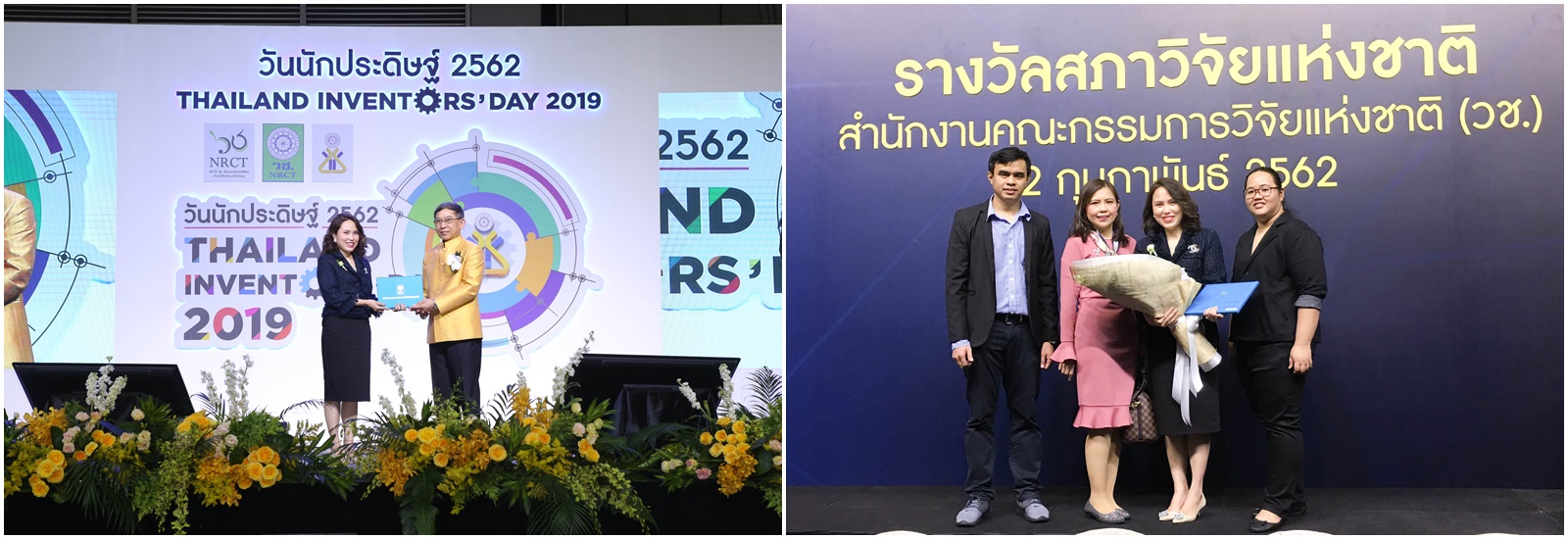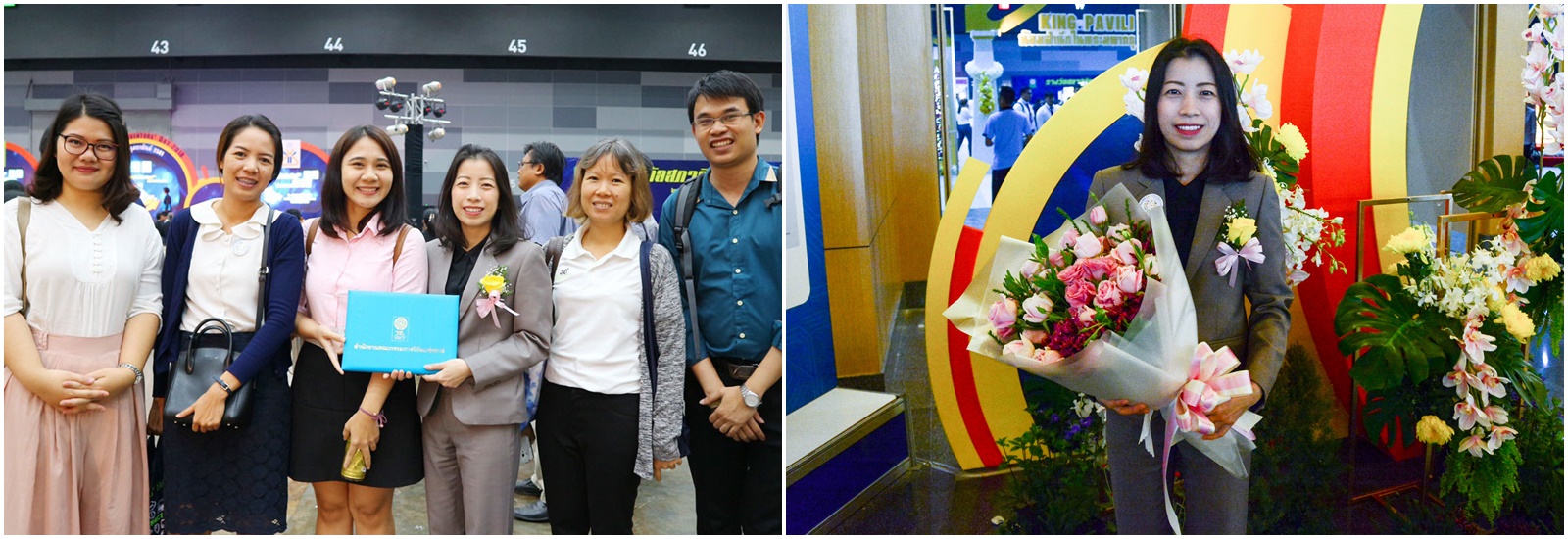เมื่อวันที่ 2 กุมภาพันธ์ 2562 สำนักงานคณะกรรมการวิจัยแห่งชาติ (วช.) ร่วมกับพันธมิตร จัดงาน “งานวันนักประดิษฐ์ ประจำปี 2562” (Thailand Inventors’ Day 2019) ฉลองครบรอบ 60 ปี และจัดพิธีมอบรางวัลสภาวิจัยแห่งชาติ ณ ศูนย์นิทรรศการและการประชุมไบเทค บางนา กรุงเทพมหานคร โดยมี พล.อ.อ.ประจิน จั่นตอง รองนายกรัฐมนตรี และรัฐมนตรีว่าการกระทรวงยุติธรรม เป็นประธานในพิธีเปิดและขึ้นมอบรางวัล

ในการนี้ ดร.สมวงษ์ ตระกูลรุ่ง ผู้อำนวยการศูนย์พันธุวิศวกรรมและเทคโนโลยีชีวภาพแห่งชาติ (ไบโอเทค) สวทช. เข้าร่วมแสดงความยินดีกับคณะวิจัยไบโอเทคที่ได้รับรางวัลสภาวิจัยแห่งชาติจำนวนทั้งสิ้น 4 รางวัล

คณะวิจัยไบโอเทคที่ได้รับรางวัลสภาวิจัยแห่งชาติจำนวนทั้งสิ้น 4 รางวัล ประกอบด้วย
รางวัลผลงานวิจัย ประจำปี 2562 รางวัลระดับดี สาขาเกษตรศาสตร์และชีววิทยา จากผลงานวิจัยเรื่อง “การพบชิ้นส่วนสารพันธุกรรมไวรัส ไอเอชเอชเอ็นแทรกในจีโนมของกุ้งกุลาดำซึ่งนำไปสู่การพัฒนาชุดตรวจไวรัสกุ้งไอเอชเอชที่มีความถูกต้องและรวดเร็ว” นำโดย ดร.วรรณวิมล ศักดิ์เสมอพรหม นักวิจัยกลุ่มวิจัยเทคโนโลยีชีวภาพสัตว์น้ำแบบบูรณาการ และคณะ

ผลงานวิจัยดังกล่าวประสบความสำเร็จในการศึกษาลำดับเบสของเชื้อไวรัสไอเอชเอชเอ็น (Infectious hypodermal and haematopoietic necrosis virus; IHHNV) ซึ่งนำไปสู่การค้นพบชิ้นส่วนสารพันธุกรรมของเชื้อไวรัสแทรกในจีโนมของกุ้งและการพัฒนาชุดตรวจที่มีความถูกต้องและรวดเร็ว โดยเชื้อไวรัสไอเอชเอชเอ็นเป็นเชื้อก่อโรคในกุ้งที่องค์การโรคระบาดสัตว์ระหว่างประเทศ (World Organisation for Animal Health หรือ Office International des Epizooties; OIE) ระบุเป็นโรคระบาดสัตว์น้ำต้องห้ามในการนำสัตว์น้ำหรือซากสัตว์น้ำเข้ามาในราชอาณาจักร ส่งผลให้ หลายประเทศมีการตรวจเชื้อก่อโรคในกุ้งที่มีการนำเข้ามาเพาะเลี้ยง ผลจากการวิเคราะห์ลำดับเบสของเชื้อไวรัส ไอเอชเอชเอ็นด้วยเทคนิค PCR นำไปสู่การพัฒนาชุดตรวจเชื้อไวรัสไอเอชเอชเอ็นด้วยเทคนิค multiplex PCR ซึ่งสามารถแยกกุ้งติดเชื้อไวรัสที่แท้จริงออกจากกุ้งที่มีสารพันธุกรรมของเชื้อไวรัสแทรกในจีโนมกุ้งได้ อย่างไรก็ตามเมื่อนำชุดตรวจดังกล่าวมาทดสอบในกุ้งกุลาดำที่เพาะเลี้ยงในประเทศไทย พบลักษณะการสอดแทรกของชิ้นส่วนสารพันธุกรรมของเชื้อไวรัส ไอเอชเอชเอ็นที่แตกต่างจากลักษณะที่พบในกุ้งกุลาดำแถบแอฟริกาตะวันออกและออสเตรเลีย ดังนั้นการตรวจเชื้อไวรัส ไอเอชเอชเอ็นด้วยเทคนิคดังกล่าวอาจทำให้เกิดผลบวกปลอมจากการสอดแทรกของชิ้นส่วนสารพันธุกรรมของเชื้อไวรัส ไอเอชเอชเอ็นได้ คณะผู้วิจัยจึงร่วมกันพัฒนาเทคนิคแลมป์ (Loop mediated isothermal amplification; LAMP) โดยใช้ไพรเมอร์ 2 ชุดที่อ้างอิงจากวิธีการตรวจโรคตาม OIE และข้อมูลที่คณะผู้วิจัยค้นพบตามลำดับ นอกจากนี้ได้พัฒนาวิธีการตรวจหาเชื้อไวรัสไอเอชเอชเอ็นด้วยเทคนิค in situ digoxigenin (DIG)-labeling LAMP (ISDL) ที่มีความจำเพาะกับเชื้อไวรัส ไอเอชเอชเอ็นมากกว่าและใช้เวลาในการตรวจน้อยกว่าเทคนิค in situ hybridization (ISH) ถึงหนึ่งในสามเท่า
รางวัลสิ่งประดิษฐ์คิดค้น ประจำปี 2562 รางวัลระดับดี สาขาเกษตรศาสตร์และชีววิทยา จากผลงานเรื่อง “เซลล์ยีสต์ลูกผสมพิเชีย พาสตอริส สำหรับการผลิตเชื้อเพลิงชีวภาพไอโซบิวทานอล” นำโดย ดร.วีรวัฒน์ รังกุพันธุ์ นักวิจัยจากกลุ่มวิจัยเทคโนโลยีไบโอรีไฟเนอรีและชีวภัณฑ์ และคณะ

เซลล์ยีสต์ลูกผสมพิเชีย พาสตอริส (Pichia pastoris) ที่คณะวิจัยพัฒนาขึ้นนี้ เป็นจุลินทรีย์ที่สามารถผลิตเชื้อเพลิงชีวภาพไอโซบิวทานอล เพื่อใช้เป็นพลังงานทดแทนได้ โดยยีสต์ดังกว่ามีจุดเด่นที่ช่วยลดต้นทุน ในการเตรียมอาหารเลี้ยงเชื้อ เติบโตเร็วย่นระยะเวลาในการหมักเชื้อ ผลิตไอโซบิวทานอลที่สูงมากขึ้น เพราะยีสต์จะไม่ผลิตเอทานอล สามารถผลิตเอนไซม์ในวิถีการย่อยชีวมวลได้ในปริมาณที่สูง เอื้อต่อการพัฒนาเชื้อเพื่อย่อยวัสดุเหลือทิ้งทางการเกษตรให้เป็นไอโซบิวทานอล เช่น กากมัน และ ชานอ้อย เป็นต้น
รางวัลระดับดี สาขาเกษตรศาสตร์และชีววิทยา จากผลงานเรื่อง “การพัฒนาชุดตรวจเครื่องหมายโมเลกุลสนิปเพื่อการตรวจเอกลักษณ์และความ บริสุทธิ์ของเมล็ดพันธุ์พืช” นำโดย ดร.วิรัลดา ภูตะคาม นักวิจัยจากศูนย์โอมิกส์แห่งชาติ และคณะ

การค้าเมล็ดพันธุ์ลูกผสมทั้งในและต่างประเทศ ได้มีการกำหนดว่าค่าความบริสุทธิ์ของเมล็ดพันธุ์ลูกผสมที่ส่งออกจำหน่ายจะต้องสูงกว่า 98% ทีมวิจัยได้พัฒนาชุดตรวจเครื่องหมายโมเลกุลสนิป เพื่อการตรวจเอกลักษณ์และความบริสุทธิ์ของเมล็ดพันธุ์แตงกวา แตงโม แตงเทศ และพริก ขึ้นเป็นครั้งแรกในประเทศไทย โดยชุดตรวจมีความถูกต้องแม่นยำสูงกว่าและมีค่าใช้จ่ายถูกกว่าวิธีดั้งเดิม นอกจากนี้ สามารถตรวจเมล็ดพันธุ์ปริมาณมากได้รวดเร็วกว่า และใช้แรงงานน้อยกว่าวิธีดั้งเดิม อีกทั้งยังได้มีการปรับแต่งให้มีความจำเพาะกับสายพันธุ์ที่ใช้กันอย่างแพร่หลายในประเทศไทย จึงสามารถตรวจเมล็ดพันธุ์ลูกผสมที่ปลูกในประเทศไทยได้เกือบทุกสายพันธุ์ เป็นการเอื้ออำนวยให้บริษัทผู้ผลิตเมล็ดพันธุ์ไทย สามารถตรวจสอบความบริสุทธิ์ของเมล็ดพันธุ์ก่อนส่งออกจำหน่ายได้อย่างรวดเร็ว ด้วยค่าใช้จ่ายที่ไม่สูง
รางวัลวิทยานิพนธ์ ประจำปี 2562 รางวัลระดับดีมาก สาขาวิศวกรรมศาสตร์และอุตสาหกรรมวิจัย จากวิทยานิพนธ์เรื่อง “โครงเลี้ยงเซลล์กระจกตาที่เหนียวและแข็งแรงทำจากคอมโพสิตไฮโดรเจลเสริมแรงเส้นใยสำหรับการผ่าตัดเปลี่ยนกระจกตา” โดย ดร.ข้าว ต้นสมบูรณ์ นักวิจัยจากกลุ่มวิจัยเทคโนโลยีการตรวจวินิจฉัยและการค้นหาสารชีวภาพ โดยมี Associate Professor Dr. Michelle Oyen จาก University of Cambridge สหราชอาณาจักร เป็นอาจารย์ที่ปรึกษาหลัก

ดร.ข้าวได้เริ่มกระบวนการศึกษาจากปัญหาด้านการแคลนกระจกตาบริจาคที่มีคุณภาพดี นำไปสู่การสร้างกระจกตาขึ้นมาใหม่จากเซลล์ของผู้ป่วยในห้องปฏิบัติการ โดยศึกษาความทนทานการฉีกขาดของกระจกตาเพื่อใช้เป็นค่ามาตรฐาน จากนั้นศึกษากลไกที่มีส่วนเพิ่มการต้านการฉีกขาดของกระจกตา พบว่าเส้นใยคอลลาเจนทำหน้าที่สำคัญในการต้านการฉีกขาดขณะที่กระจกตาโดนดึงได้ จนนำไปสู่การพัฒนาคอมโพสิตไฮโดรเจลเสริมแรงด้วยเส้นใยที่เลียนแบบโครงสร้างและคุณสมบัติของกระจกตา ทนต่อการฉีกขาดและการดึงมากกว่าเดิมกว่าร้อยเท่า สามารถใช้แทนกระจกตาบริจาคในการผ่าตัดเปลี่ยนกระจกตาเพื่อช่วยให้ผู้ป่วยมองเห็นอีกครั้งได้อย่างปลอดภัย
“งานวันนักประดิษฐ์” (Thailand Inventors’ Day) จัดขึ้นในวันที่ 2 กุมภาพันธ์ ของทุกปี โดยสำนักงานคณะกรรมการวิจัยแห่งชาติ (วช.) และหน่วยงานพันธมิตร ในปี 2562 ถือเป็นการจัดงานครั้งที่ 21 เพื่อนำเสนอสิ่งประดิษฐ์และนวัตกรรม พร้อมใช้และความก้าวหน้าด้านการประดิษฐ์คิดค้นของประเทศให้เกิดการขยายผลและนำไปใช้ประโยชน์ในมิติต่างๆ สอดคล้องกับเป้าหมายของยุทธศาสตร์ชาติระยะ 20 ปี และเป้าหมายประเทศไทย 4.0 ในการนำการวิจัยและนวัตกรรมเป็นกลไกสำคัญในการขับเคลื่อนเศรษฐกิจและการพัฒนาสังคมของประเทศ
BIOTEC researchers honored with NRCT awards 2019
The National Research Council of Thailand (NRCT) has announced the 2019 NRCT Awards to honor outstanding researchers and research. The award ceremony was held on 2nd February 2019 as part of a celebration of Thailand Inventors’ Day 2019 at Bangkok International Trade & Exhibition Centre (BITEC), Thailand. The NRCT awards were presented in four categories, including National Outstanding Researcher Award, Research Work Award, Dissertation Award, and Invention Award.
BIOTEC’s team has won 4 awards across 3 award categories. The winners were congratulated by Dr. Somvong Tragoonrung, BIOTEC Executive Director.
“Discovery of random genome fragments of IHHNV Infectious Hypodermal and Hematopoietic Necrosis Virus in the giant tiger shrimp genome and its implication for developing more accurate and sensitive viral diagnosis” won Research Work Award in Agriculture and Biotechnology – Good Level. The work was a coalition effort led by Dr. Vanvimon Saksmerprome and the Fish and Shrimp Molecular Biology and Biotechnology Research Team and Ms. Wansika Kiatpathomchai and the Bioengineering and Sensing Technology Research Team in collaboration with Faculty of Science, Mahidol University.
Infectious hypodermal and hematopoietic necrosis virus (IHHNV) is also known as Penaeus stylirostris densovirus (PstDNV). Since it is listed as a reportable crustacean disease by the World Organization for Animal Health (OIE), many countries require testing for IHHNV in shrimp stocks imported for aquaculture. The teams were able to successfully develop the multiplex PCR assay to cover most of the whole IHHNV genome.
Moreover, non-infectious inserts of IHHNV genome into the shrimp genome have been found in captured P. monodon from East Africa and Australia. The occurrence of these inserts raised the question as to whether inserts of other IHHNV fragments also occurred in the P. monodon genome. The multiplex PCR assay using overlapping primer pairs to cover the whole IHHNV genome, developed from the previous IHHNV sequence analysis mentioned above, indicate that IHHNV inserts are common and variable in P. monodon from Thailand and that they may yield false-positive test results for infectious IHHNV using currently recommended methods. The multiplex PCR developed proved optimal for convenient differentiation of shrimp specimens with real IHHNV infection and those with insert types. Based on the data, 2 sets of primers for Loop-mediated isothermal amplification (LAMP) were developed for highly sensitive method. The real IHHNV infected shrimp gave positive results in both LAMP primer sets. Using the LAMP technique, a new, highly sensitive method for detection of IHHNV in shrimp tissues was developed combining with DIG-labelling, called ISDL, to enhance detection signal. The ISDL method gave no cross- reactions with tissues of shrimp infected with other common pathogens, and the total time needed to carry out ISDL was one-third of that needed for conventional in situ hybridization.
The project on “Genetically Engineered Pichia pastoris Capable of Producing the Biofuel Isobutanol” was presented with Invention Award in Agriculture and Biotechnology – Good Level.
Microbial production of high-energy fuel via environmentally sustainable and economically efficient bioprocesses is vital to the development of bioeconomy. Dr. Weerawat Runguphan and the Microbial Cell Factory Research Team have successfully engineered the yeast Pichia pastoris, a popular choice in heterologous enzyme production, to produce the biofuel isobutanol and isobutylacetate from two renewable carbon sources, glucose and glycerol. P. pastoris offers several advantages as a microbial chassis over other yeast species including i) P. pastoris can utilize multiple renewable carbon sources; ii) P. pastoris exhibits fast growth rate and can grow to a very high density; iii) P. pastoris is a Crabtree-negative yeast; and iv) P. pastoris has demonstrated robust heterologous expression of cellulolytic and hemicellulolytic enzymes, which should make the organism an attractive host for consolidated bioprocessing of biofuels and other chemicals from biomass.
The engineered yeast was able to produce isobutanol at a titer of 2.22 g/L in minimal medium.
“SNP Genotyping Kits for Cultivar Identification and Seed Purity Test in Cucumber, Watermelon, Melon and Chili Pepper” was honored with Invention Award in Agriculture and Biotechnology – Good Level. The work was led by Dr. Wirulda Pootakham and the team from the National Omics Center.
Seed purity testing is a crucial step in the hybrid seed industry since it is used to determine the genetic purity of exported hybrid seeds. However, the conventional approach of seed purity testing is extremely laborious, time-consuming and not very accurate.
Seed production companies are required to demonstrate that the purity of the exported hybrid seeds is at least 98%. The purity of hybrid seeds is conventionally assayed by conducting “grow-out-trial” involving the germination of the seeds to obtain full-grown plants for a visual assessment of morphological characteristics. The process is laborious, time-consuming (up to 12 months) and does not yield accurate results. The team has successfully developed DNA-based purity test, using single nucleotide polymorphism (SNP) markers to validate the genetic purity of hybrid seeds. The newly developed purity test provides a much more rapid (3-6 days) and accurate method for seed purity testing. The SNP-based testing can also be carried out in a high-throughput manner and is not as labor-intensive compared to the conventional approach. Besides, SNP purity testing kits developed by the team was designed specifically with varieties that are commonly cultivated in Thailand. As the first SNP-based purity test available in Thailand, both local and large seed companies will have access to rapid and highly accurate seed purity test to ensure only high-quality hybrid seeds are released to the market.
Supervised by Associate Professor Dr. Michelle Oyen, Dr. Khaow Tonsomboon’s Ph.D dissertation entitled “Strong and tough Fibre-Reinforced Hydrogel Composite Corneal Scaffolds for Corneal Transplantation” was awarded Dissertation Award in Biomaterials Engineering – Excellent Level.
The cornea is the eye’s outermost layer. This clear, dome-shaped surface plays an important role in visual acuity. Severe shortage of good quality donor cornea is now an international crisis in public health. Substitutes for donor tissue need to be developed to meet the increasing demand for corneal.
Lab-grown corneal tissues from patient cells or tissue-engineered corneas is promising alternative material for corneal transplantation. Dr. Tonsomboon and team seeks to develop frameworks for the manufacturing of corneal scaffolds with sufficient toughness and controllable microstructure and properties.
The fracture behaviour of corneal tissue was investigated in order to establish a benchmark for the scaffold mechanical performance. Examination was then carried out on the mechanisms that the corneal tissue employs to achieve toughness in order to use as a guideline in designing tough biomimetic corneal scaffolds. Corneal collagen fibres were found to play a key role in toughening the tissue and preventing significant damage during fracture. This result led to the development of fibre-reinforced composite hydrogels to mimic the fibre-reinforced nature of the native cornea. Dr.Tonsomboon has successfully used electrospun gelatin nanofibrous networks to enhance both mechanical strength and toughness of the brittle and weak hydrogels. The novel fibre-reinforced composite hydrogels can be safely used in clinical applications to restore vision when donor tissue is unavailable.
Dr. Khaow Tonsomboon, Microarray Research Team, received his Ph.D in Engineering from University of Cambridge in 2015.

